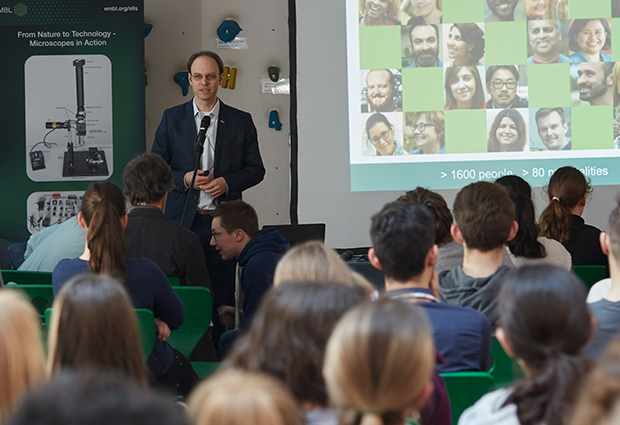
Science in a suitcase
School students build fluorescence microscopes designed by members of the Prevedel group and ELLS

A fluorescence microscope can be like a magic box. If you twiddle the buttons just right, you can get informative and beautiful images. Yet understanding how one works is easier to grasp if you can build one. This is what students at the Internationale Gesamtschule Heidelberg (IGH) did, as part of the microscopy project, “From Nature to Technology – Microscopes in Action”, organised by EMBL’s teacher training programme, ELLS, and the Prevedel group. Students aged 15-16 years, built fluorescence microscopes from parts packaged within a portable kit and imaged biological specimens. On the 5th of March, Robert Prevedel, group leader at EMBL Heidelberg, spoke at IGH and answered questions from students.
Curious students
Throughout February, students at the IGH took part in a series of four 90-minute sessions that transformed the classroom into a lab. Working in small groups, students built fluorescence microscopes, capable of imaging biological samples hundreds of micrometres in size. Fragile lenses and research grade objectives make up the kit, so protective gloves were donned. The laboratory experience continued as students prepared biological samples, practiced using research-grade micro-pipettes for the first time and got the opportunity to visit EMBL before and after their classroom sessions. Here, they saw the inner workings of much larger fluorescence microscopes and gained an insight into how these are used in research.

To conclude the project, students showcased what they had learnt in a poster presentation on the 5th of March. Robert Prevedel also gave a talk at the school and answered questions from curious students. The local press came and the room was packed with around 150 students filling seats and more crowding in at the back. “I felt the project worked well, and the turn out for the presentation today reflected that,” says Robert Prevedel. “We initially designed this project for the predoctoral course at EMBL, but with the support of the teachers and ELLS, it could be modified to fit into a classroom setting.”
Skills for success
By successfully building a fluorescence microscope, the students showed a thorough and solid understanding of the textbook physics and biology they had learnt in the classroom. Determination, problem-solving, and teamwork were also required to complete this project. Yet these students rose to the challenge. “It was amazing what we were able to see under the microscope,” says one student, “you felt like you were in a proper laboratory.” Christoph Hedicke, the students’ teacher agrees. “It was a great opportunity for the students to work in a practical setting. It asked a lot of the students but they are open and curious to learn.”
Continued support
The project was generously funded by the Dr. Rolf M Schwiete Stiftung and the Zukunft Metropolregion Rhein-Neckar e.V., with continued support from Friends of EMBL. This project helps to make STEM subjects more accessible to school students. The fluorescence microscopes, originally designed by members of the Prevedel group and adapted by ELLS, easily fit into portable suitcases. “We received very good feedback from the students,” says Agnes Szmolenszky, Head of ELLS. “The plan now is to make this project a self-contained teaching resource for schools, first here in the region and then nationwide.”


